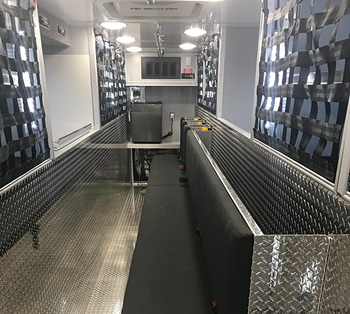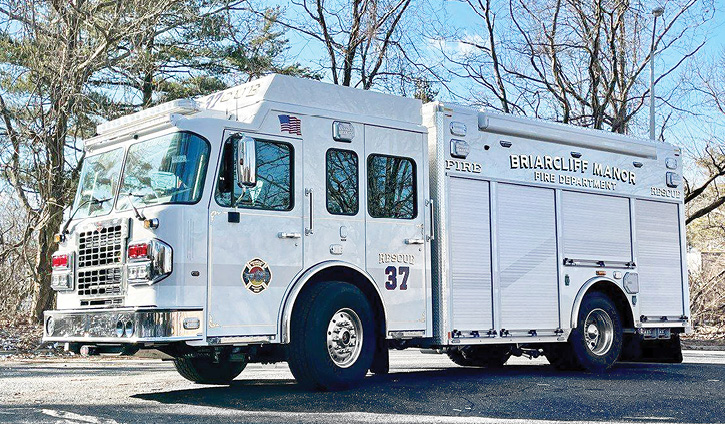A fire department’s geographic location and its apparatus equipment carrying preferences are two major determining factors for whether the department chooses a walk-in or walk-around rescue, according to fire apparatus manufacturers. Rescue truck makers spend plenty of time and effort working with truck committees on those departmental preferences, figuring out how they can best satisfy the particular needs of each agency.
Bill Proft, rescue products business unit director for Pierce Manufacturing Inc., says, “For the last couple of years, the choice of rescues has been 50/50 for us, but we’re seeing a greater percentage of fire departments going to walk-in rescues compared with seven or eight years ago. Many of them use the walk-in space for rehab purposes as well as interior equipment storage.”
Proft notes that he sees walk-in rescues used on the East Coast, especially the two-door cab style with walk-in access from the rear of the truck. “It’s the old-style rescue truck,” he says. “When it comes to rescues with dedicated space for a command area or a laboratory, we see a lot of those in the West, especially in California.” He notes that Pierce recently built a walk-in rescue for the Princeton (NJ) Fire Department with a four-door crew cab that has a cab-to-body walk-through, with a small area up front to seat a couple of firefighters.
- Walk-In or Walk-Around Rescue Trucks? (August/2017)
- Dollars and Sense: Rescue Truck Options (June/2017)
- Fire Departments, Builders Weigh in on Big vs. Small Rescue Trucks
- Walk-In Rescue Trucks Archives
Proft adds that the interiors of walk-ins have changed considerably. “Instead of plywood and laminates for the ceilings and upper side walls, now departments are putting in aluminum and stainless steel coverings and securing smaller tools like halligans and axes onto side walls or countertops,” he says.
Tony Klanderud, apparatus program manager for Rosenbauer, says in the past year or so Rosenbauer has built about the same number of walk-in rescues as walk-arounds. “There seems to be a trend toward the single-rear-axle style for both types,” Klanderud points out. “We also are seeing more city-style walk-in rigs to carry personnel and also use as rehab units. But in outlying areas, the trend is toward walk-arounds, which have the ability to carry more equipment and gear of larger sizes like rescue struts and plywood.”
Mark Brenneman, assistant sales manager for 4 Guys Fire Trucks, says the balance between the rescue trucks at his company also has been 50/50. “We’ve built rescues from a 12-foot body walk-around to a 25-foot body walk-in with rear-door access,” he says. “In the past, we’ve done some walk-ins with side doors but never one with both side- and rear-door access.”
The downside to a walk-in rescue, Brenneman believes, is the loss of some compartment space. “With a walk-around rescue, we can put in a transverse compartment on the rig to hold large pieces of equipment, sheets of plywood, masses of cribbing, or other big gear,” he says.
Michael Cox, vice president of sales for Emergency Vehicles Inc. (EVI), agrees with Proft that walk-in rescues are making a comeback. “We’re seeing a resurgence of the older, heavy city-style walk-in rescues on tandem rear axles with doors at the rear,” Cox says. “And, then there’s the combination style rescue like the truck we built for the Limerick (PA) Fire Department that has a walk-in front and a nonwalk-in rear, which gave them the option of a transverse compartment at the rear.”

1 Pierce Manufacturing Inc. built this walk-in heavy rescue on an Arrow XT cab and chassis with a single rear axle for West End (PA) Fire & Rescue. (Photo 1 courtesy of Pierce Manufacturing Inc.)

2 4 Guys Fire Trucks built this walk-in heavy rescue on a Mack chassis with tandem rear axle and power train for the Maugansville (MD) Goodwill Volunteer Fire Company. (Photo 2 courtesy of 4 Guys Fire Trucks.)

3 The interior of this walk-in rescue that Emergency Vehicles Inc. built is covered in aluminum diamond plate. (Photo 3 courtesy of Emergency Vehicles Inc.)

4 Rescue 1 built this walk-around rescue on a single rear axle for the Briarcliff Manor (NY) Fire Department. (Photo 4 courtesy of Rescue 1.)

5 Fort Garry Fire Trucks built this custom chassis walk-around heavy for the Parksville (BC) Fire Department. (Photo 5 courtesy of Fort Garry Fire Trucks.)

6 South Haven (MI) Area Emergency Services had Spencer Manufacturing build this combination walk-in and walk-around rescue truck on a Freightliner M2-106 chassis with an 18-foot 7-inch rescue box. (Photo 6 courtesy of Spencer Manufacturing Inc.)

7 Spartan Emergency Response built this walk-around heavy rescue for the Charlestown (IN) Volunteer Fire Department. (Photo 7 courtesy of Spartan Emergency Response.)

8 Summit Fire Apparatus built this walk-around heavy rescue for the Cranston (RI) Fire Department. (Photo 8 courtesy of Summit Fire Apparatus.)
While there are pros and cons to both types of rescues, Cox notes that walk-in rescues allow firefighters to use the walk-in area as a command unit, a hazmat unit, or a climate-controlled space where they can put on water rescue or dive suits. “Firefighters can rehab inside a walk-in rescue, and the space is great for storage of meters and other equipment that shouldn’t be in exterior compartments,” he says.
Brad Turk, regional sales manager for Rescue 1, notes that in the past year, walk-arounds have been the most popular build at his company. “Three years ago, walk-ins were more popular,” Turk says, “so it goes to show that things are cyclical in this business.” Turk thinks that walk-arounds have become more popular because of staffing issues, especially with volunteer fire companies. “Departments also are looking to carry as much equipment as they can to a scene, because they might not have the firefighters to staff an additional vehicle,” he says. “That may be why they are choosing the walk-around style, which can hold more equipment and other gear than a walk-in.”
Laura Scherza, contract administrator for Fort Garry Fire Trucks, says Fort Garry recently built a heavy walk-in rescue on a custom chassis for the Norfolk County (ON) Fire Department. “The truck provides not only rescue but also a command and control capability,” Scherza says. “It’s built on a Spartan Metro star chassis with a 20-inch raised roof and a 20-foot full-framed extruded 5083 saltwater marine-grade aluminum body, holding an interior command post and storage in the walk-in area. The rescue has a 35-foot telescoping mast with a pan/tilt/zoom camera system at the top.”
Fort Garry also built a custom chassis walk-around heavy rescue for the Parksville (BC) Fire Department on a Spartan Metro Star chassis and an 18-foot full-framed extruded 5083 saltwater marine-grade aluminum body, with high-side compartments all around holding sliding trays, panels, racks, and specialty tool holders. Scherza notes the truck has corner anchor points at the top of the body, designed for low-angle rescue in rough terrain, and low anchor points at the rub rail that can be used for low-angle rescue or as winch points.
Alex Hobday, sales engineer for Spencer Manufacturing Inc., says Spencer has built more walk-around rescues recently, generally on commercial chassis and cabs with 18- to 20-foot bodies. “We also have built a small number of partial walk-in rescues,” Hobday says, “like the rig we built for the South Haven (MI) Fire Department. It has an 18-foot box with access through a curbside door where the front half holds a walk-in command unit with a small bench seat and swing-down desk. The truck runs first out on water-related calls, and the officer can coordinate the rescue from inside the truck.”
Chris Wade, director of sales for Spartan Emergency Response, says that while rescues are a small part of the orders handled by his company, which offers both walk-in and walk-around models, he has seen a drop in requests for walk-in rescues in the past year or two. “The story is different for every department,” he observes. “What they need is dependent on the truck’s mission and role, and there is no one-size-fits-all solution. But, we are doing a lot more walk-around rescues these days.”
Joe Messmer, president of Summit Fire Apparatus, observes that Summit saw a trend away from walk-in rescues to walk-arounds about 15 years ago. “Departments weren’t using walk-ins much because their custom cabs carried the firefighters needed to fight a fire,” Messmer says. “And, with a walk-around, you can haul more equipment to a scene, and for those departments that want a command area inside the cab, we build a small walk-in area at the back of the cab with a pull-out desk, movable seats, and flip-down shelves so an officer can run a scene from inside the cab.”
ALAN M. PETRILLO is a Tucson, Arizona-based journalist, the author of three novels and five nonfiction books, and a member of the Fire Apparatus & Emergency Equipment Editorial Advisory Board. He served 22 years with the Verdoy (NY) Fire Department, including in the position of chief.

